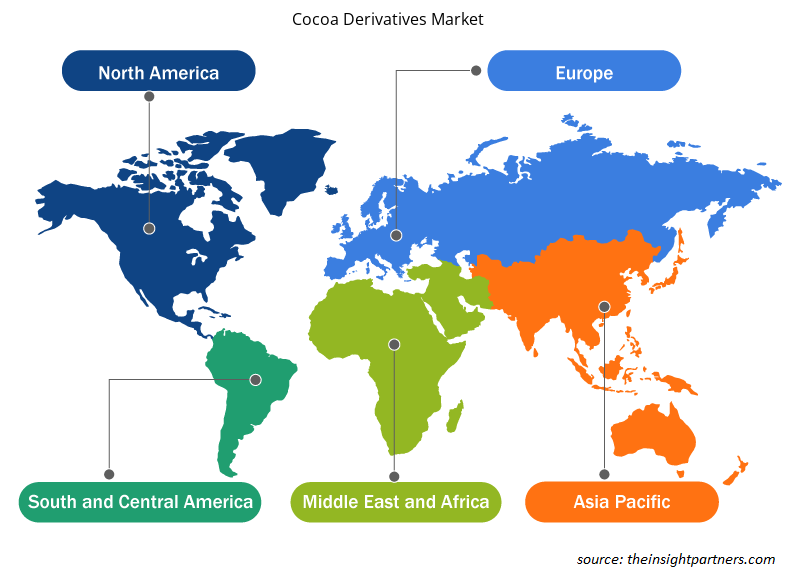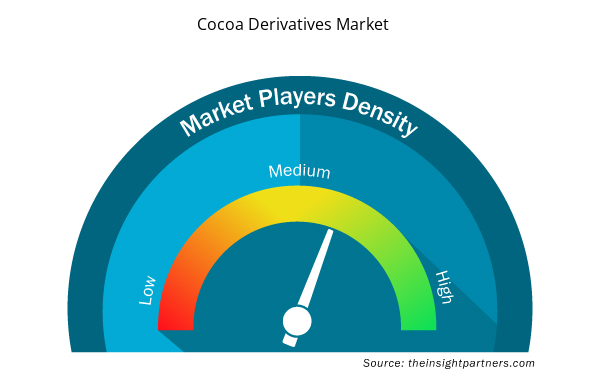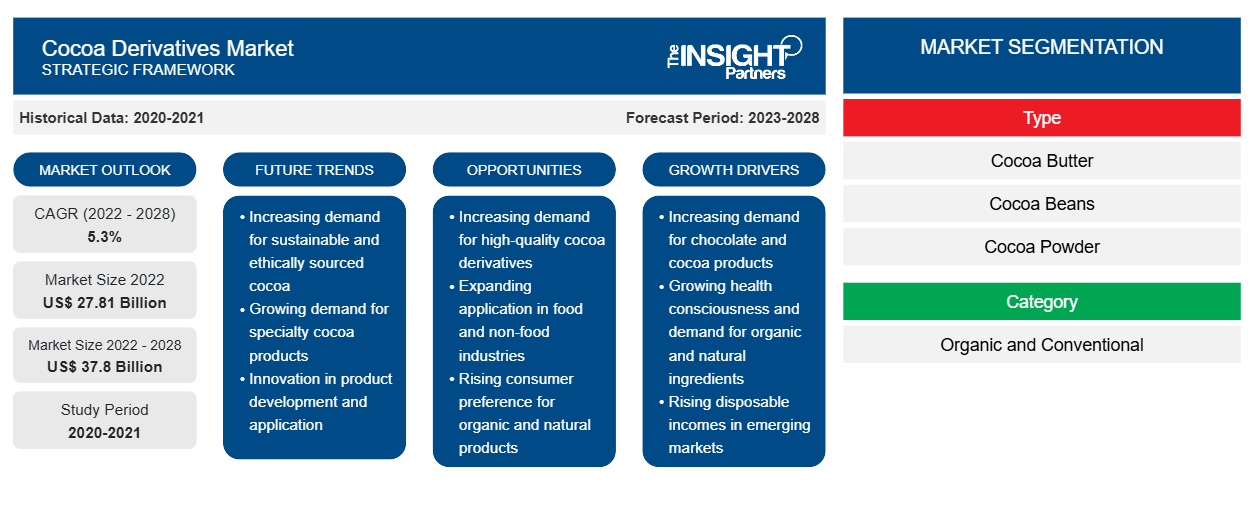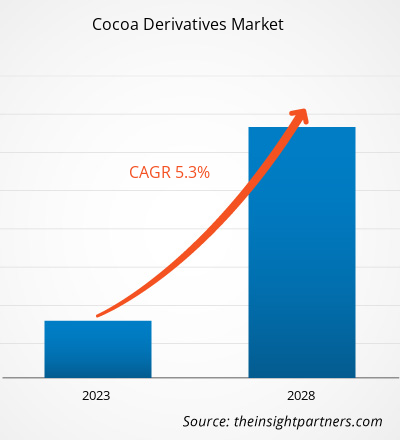Der Markt für Kakaoderivate soll von 27.807,13 Millionen US-Dollar im Jahr 2022 auf 37.799,86 Millionen US-Dollar im Jahr 2028 wachsen; für den Zeitraum von 2022 bis 2028 wird eine durchschnittliche jährliche Wachstumsrate (CAGR) von 5,3 % erwartet.
Kakaoderivate sind Kakaoprodukte, die aus der Verarbeitung von Kakao gewonnen werden. Zu den Arten von Kakaoderivaten gehören Kakaobohnen, Kakaobutter und Kakaopulver. Diese Derivate sind auch in den Kategorien Bio und Konventionell erhältlich. Die Nachfrage nach Bio- und Fairtrade-zertifizierten Kakaobohnen wächst auf dem Weltmarkt. Verbraucher neigen dazu, sicherere Produkte zu konsumieren, die ihnen helfen, ihre allgemeine Gesundheit zu erhalten. Das steigende Interesse an pestizidfreien Lebensmitteln wirkt sich positiv auf die Nachfrage nach biologisch angebautem Kakao aus. Laut dem Bericht „World of Organic Agriculture 2022“ des Forschungsinstituts für biologischen Landbau ( FiBL ) und der International Federation of Organic Agriculture Movements ( IFOAM ) erreichte die Anbaufläche für Bio-Kakao weltweit im Jahr 2020 3,1 %. Darüber hinaus haben Lindt & Sprüngli angegeben, dass der Umsatz ihrer Bio-Kakaoprodukte in Europa viel schneller wächst als der Gesamtumsatz mit Kakaoprodukten. Daher nehmen Hersteller Bio-Produkte in ihr Portfolio auf, um der steigenden Nachfrage gerecht zu werden. Beispielsweise bietet Barry Callebaut im Inland produziertes, bio-zertifiziertes, nicht alkalisiertes Kakaopulver an.
Im Jahr 2022 hielt Europa den größten Anteil am Markt für Kakaoderivate . Der Markt im Asien-Pazifik-Raum wird im Prognosezeitraum voraussichtlich mit der höchsten CAGR wachsen . Das Marktwachstum in der Region wird auf die zunehmende Beliebtheit von Gourmet-Schokolade unter den Europäern zurückgeführt. Daher haben verschiedene hochwertige Schokoladenmarken intensiv nach Möglichkeiten gesucht, ihre Produkte zu differenzieren, und sich gleichzeitig auf die Beschaffung von Produkten aus einer einzigen Plantage konzentriert. Daher steigt die Nachfrage nach hochwertigem Kakao und Kakaoaromen aus einer einzigen Anbauregion in der Region. So erntet beispielsweise Valrhona Inc., der weltbeste Schokoladenproduzent mit Sitz in Frankreich, Kakaobohnen von Maria Trinidad Sanchez, einer Kakaoplantage mit einer einzigen Anbauregion aus. Darüber hinaus löst die Neigung der Verbraucher zu einem gesunden Lebensstil eine Nachfrage nach Kakaoderivaten höchster Qualität wie Kakaobutter, Kakaopulver und Kakaobohnen aus.
Passen Sie diesen Bericht Ihren Anforderungen an
Sie erhalten kostenlose Anpassungen an jedem Bericht, einschließlich Teilen dieses Berichts oder einer Analyse auf Länderebene, eines Excel-Datenpakets sowie tolle Angebote und Rabatte für Start-ups und Universitäten.
- Holen Sie sich die wichtigsten Markttrends aus diesem Bericht.Dieses KOSTENLOSE Beispiel umfasst eine Datenanalyse von Markttrends bis hin zu Schätzungen und Prognosen.
Auswirkungen der COVID-19-Pandemie auf den Markt für Kakaoderivate
Die COVID-19-Pandemie hatte Auswirkungen auf die Volkswirtschaften und Industrien zahlreicher Länder. Lockdowns , Reisebeschränkungen und Betriebsschließungen in Nordamerika, Europa, im asiatisch-pazifischen Raum ( APAC ), Süd- und Mittelamerika (SAM) sowie im Nahen Osten und Afrika ( MEA ) behinderten das Wachstum mehrerer Industrien, darunter auch der Lebensmittel- und Getränkeindustrie. Die Schließung von Produktionseinheiten führte zu Störungen der globalen Lieferketten, Fertigungsaktivitäten, Lieferpläne sowie des Verkaufs lebensnotwendiger und nicht lebensnotwendiger Produkte. Verschiedene Unternehmen erlebten im Jahr 2020 Verzögerungen bei der Produktlieferung und einen Einbruch der Verkäufe ihrer Produkte. Darüber hinaus zwangen die von den Regierungen verschiedener Länder in Europa, im asiatisch-pazifischen Raum und in Nordamerika verhängten Reiseverbote die Unternehmen dazu, ihre Kooperations- und Partnerschaftspläne vorübergehend einzustellen. All diese Faktoren behinderten 2020 und Anfang 2021 verschiedene Industrien und bremsten so das Wachstum verschiedener Märkte.
Veränderungen der sozioökonomischen Situation wirkten sich 2020 negativ auf das Konsumverhalten von Premiumprodukten aus. Die während der globalen Krise von den Regierungen mehrerer Länder verhängten Beschränkungen verursachten für Kakaobauern in kleinen, aber wichtigen Kakao produzierenden Ländern finanzielle Verluste, da die Produktion in den ersten Monaten der Pandemie die Nachfrage überstieg. Dies führte zu einem deutlichen Rückgang der Kakaopreise. Nach Angaben der Internationalen Kakaoorganisation ( ICCO ) in New York lagen die Vertragspreise für Kakao im Januar 2021 bei durchschnittlich ~2.528 US-Dollar pro Tonne, was einem Rückgang von 6 % gegenüber dem Vorjahreswert (2.675 US-Dollar pro Tonne) entspricht. Darüber hinaus beeinträchtigte die Schließung von Betrieben in der Körperpflege- und Nahrungsmittel- und Getränkeindustrie die Entwicklung des Marktes für Kakaoderivate.
Im Jahr 2021 nahmen mehrere Volkswirtschaften ihren Betrieb wieder auf, als die Regierungen Lockerungen der zuvor verhängten Beschränkungen ankündigten, was dem globalen Markt Auftrieb gab. Darüber hinaus durften die Hersteller mit voller Kapazität arbeiten, was ihnen half, die Nachfrage- und Angebotslücken sowie andere Auswirkungen zu überwinden. Da bis 2021 ein Großteil der Weltbevölkerung vollständig geimpft war, konzentrierten sich die Hersteller von Kakaoderivaten darauf, ihre Produktionsabläufe auszuweiten, um ihre Geschäfte wiederzubeleben.
Markteinblicke
Strategische Entwicklungen wichtiger Akteure begünstigen Wachstum auf dem Markt für Kakaoderivate
Im September 2020 brachte die Olam Group Ltd Olam Cocoa für Profis auf den Markt und machte ihre hochwertigen deZaan-Kakaopulver für Restaurants, Catering-Unternehmen und Konditoreien verfügbar. Die Strategie zielte darauf ab, der steigenden Nachfrage nach hochwertigen Kakaozutaten von professionellen Köchen und Bäckern gerecht zu werden. Solche strategischen Entwicklungen der wichtigsten Marktteilnehmer dürften das Wachstum des Marktes für Kakaoderivate in den kommenden Jahren vorantreiben.
Typ-Einblicke
Der Markt für Kakaoderivate ist nach Typ in Kakaobohnen, Kakaobutter , Kakaopulver und andere unterteilt. Das Segment Kakaobohnen hatte 2022 den größten Marktanteil, und das Segment Kakaopulver wird im Prognosezeitraum voraussichtlich die höchste durchschnittliche jährliche Wachstumsrate verzeichnen. Kakaopulver ist ein ungesüßtes Pulver, das durch das Zerkleinern von Kakaobohnen gewonnen wird, die aus den Früchten von Kakaobäumen gewonnen werden. Die Schokoladenmasse wird gepresst, um die Kakaobutter zu entfernen, und die restlichen Kakaofeststoffe werden dann verarbeitet, um ein feines ungesüßtes Kakaopulver herzustellen. Die zunehmende Vorliebe der Verbraucher für besseren Geschmack, Farbe und Textur treibt die Nachfrage nach Kakaopulver an.
Anwendungseinblicke
Basierend auf der Anwendung ist der Markt für Kakaoderivate in Lebensmittel und Getränke, Körperpflege und andere unterteilt. Kakaoderivate werden häufig zur Herstellung von Backwaren, Getränken, Süßwaren, Milchprodukten und Snacks verwendet. Eine aufkommende Nachfrage nach Clean-Label- und veganen Produkten führt jedoch zu einem Anstieg der Verkäufe von pflanzlichen Zutaten wie Kakaobutter, Kakaopulver, Kakaonibs und Kakaomasse. Daher treibt die steigende Nachfrage nach pflanzlichen Produkten in der Lebensmittel- und Getränkeindustrie das Wachstum des Marktes für Kakaoderivate an. Olam International und Cargill, Incorporated sind die wichtigsten Hersteller, die Kakaoderivate für Lebensmittel- und Getränkeanwendungen anbieten.
Zu den wichtigsten Akteuren auf dem Markt für Kakaoderivate zählen Olam Group Ltd, Indcre SA, Cargill Inc, Natra SA, JB Foods Ltd, Ecuakao Group Ltd, United Cocoa Processor Inc, Barry Callebaut AG, Moner Cocoa SA und Altınmarka Gıda San ve Tic AS. Diese Unternehmen konzentrieren sich hauptsächlich auf Produktinnovationen, um ihren Markt zu vergrößern und neuen Trends zu folgen.
Regionale Einblicke in den Markt für Kakaoderivate
Die regionalen Trends und Faktoren, die den Markt für Kakaoderivate im Prognosezeitraum beeinflussen, wurden von den Analysten von Insight Partners ausführlich erläutert. In diesem Abschnitt werden auch die Marktsegmente und die Geografie von Kakaoderivaten in Nordamerika, Europa, im asiatisch-pazifischen Raum, im Nahen Osten und Afrika sowie in Süd- und Mittelamerika erörtert.

- Erhalten Sie regionale Daten zum Markt für Kakaoderivate
Umfang des Marktberichts über Kakaoderivate
| Berichtsattribut | Details |
|---|---|
| Marktgröße im Jahr 2022 | 27,81 Milliarden US-Dollar |
| Marktgröße bis 2028 | 37,8 Milliarden US-Dollar |
| Globale CAGR (2022 - 2028) | 5,3 % |
| Historische Daten | 2020-2021 |
| Prognosezeitraum | 2023–2028 |
| Abgedeckte Segmente | Nach Typ
|
| Abgedeckte Regionen und Länder | Nordamerika
|
| Marktführer und wichtige Unternehmensprofile |
|
Marktteilnehmerdichte für Kakaoderivate: Auswirkungen auf die Geschäftsdynamik verstehen
Der Markt für Kakaoderivate wächst rasant, angetrieben durch die steigende Nachfrage der Endverbraucher aufgrund von Faktoren wie sich entwickelnden Verbraucherpräferenzen, technologischen Fortschritten und einem größeren Bewusstsein für die Vorteile des Produkts. Mit steigender Nachfrage erweitern Unternehmen ihr Angebot, entwickeln Innovationen, um die Bedürfnisse der Verbraucher zu erfüllen, und nutzen neue Trends, was das Marktwachstum weiter ankurbelt.
Die Marktteilnehmerdichte bezieht sich auf die Verteilung der Firmen oder Unternehmen, die in einem bestimmten Markt oder einer bestimmten Branche tätig sind. Sie gibt an, wie viele Wettbewerber (Marktteilnehmer) in einem bestimmten Marktraum im Verhältnis zu seiner Größe oder seinem gesamten Marktwert präsent sind.
Die wichtigsten auf dem Markt für Kakaoderivate tätigen Unternehmen sind:
- Olam Group GmbH
- Indcre SA
- Cargill Inc
- Natra SA
- JB Foods Ltd
Haftungsausschluss : Die oben aufgeführten Unternehmen sind nicht in einer bestimmten Reihenfolge aufgeführt.

- Überblick über die wichtigsten Akteure auf dem Markt für Kakaoderivate
Bericht-Spotlights
- Fortschrittliche Branchentrends auf dem Markt für Kakaoderivate helfen Unternehmen bei der Entwicklung wirksamer langfristiger Strategien
- Von Marktteilnehmern in Industrie- und Entwicklungsländern verfolgte Strategien für Unternehmenswachstum
- Quantitative Analyse des Marktes von 2022 bis 2028
- Schätzung der weltweiten Nachfrage nach Kakaoderivaten
- Porters Fünf-Kräfte-Analyse zur Veranschaulichung der Wirksamkeit von Käufern und Lieferanten auf dem Markt für Kakaoderivate
- Aktuelle Entwicklungen zum Verständnis des Wettbewerbsmarktszenarios
- Markttrends und -aussichten sowie Wachstumstreiber und -hemmnisse auf dem Markt für Kakaoderivate
- Unterstützung im Entscheidungsprozess durch Aufzeigen von Marktstrategien, die das kommerzielle Interesse untermauern
- Größe des Kakaoderivatemarktes an verschiedenen Knotenpunkten
- Detaillierte Übersicht und Segmentierung des Marktes und der Wachstumsdynamik der Kakaoderivateindustrie
- Größe des Kakaoderivatemarktes in verschiedenen Regionen mit vielversprechenden Wachstumschancen
- Historische Analyse (2 Jahre), Basisjahr, Prognose (7 Jahre) mit CAGR
- PEST- und SWOT-Analyse
- Marktgröße Wert/Volumen – Global, Regional, Land
- Branche und Wettbewerbsumfeld
- Excel-Datensatz



Report Coverage
Revenue forecast, Company Analysis, Industry landscape, Growth factors, and Trends

Segment Covered
This text is related
to segments covered.

Regional Scope
North America, Europe, Asia Pacific, Middle East & Africa, South & Central America

Country Scope
This text is related
to country scope.
Häufig gestellte Fragen
The rising demand for cocoa-based confectioneries and the utilization of cocoa as a sustainable beauty ingredient by the cosmetic industry are some of the key driving factors for the cocoa derivatives market.
Based on application, personal care is the fastest-growing segment in the cocoa derivatives market due to its high antioxidant properties and its richness in flavanols.
Europe accounted for the largest share of the global cocoa derivatives market. The market growth is attributed to the increasing popularity of specialty chocolates among the European population which boost the demand for cocoa derivatives.
Based on the type, the cocoa beans segment accounted for the largest revenue share as it promotes healthy digestion due to their fibre content. The fibre content helps soften bowel movements, prevent haemorrhoids and help with other digestive conditions. it finds wide application in industries such as food & beverage, confectionery, and pharmaceuticals.
Increasing demand for organic and fairtrade cocoa derivatives is further expected to create lucrative opportunities for cocoa derivatives market growth.
The major players operating in the global cocoa derivatives market are Olam Group Ltd, Indcre SA, Cargill Inc, Natra SA, JB Foods Ltd , Ecuakao Group Ltd, United Cocoa Processor Inc, Barry Callebaut AG, Moner Cocoa SA, Altınmarka Gıda San ve Tic AS among few others.
Trends and growth analysis reports related to Food and Beverages : READ MORE..
The List of Companies - Cocoa Derivatives Market
- Olam Group Ltd
- Indcre SA
- Cargill Inc
- Natra SA
- JB Foods Ltd
- Ecuakao Group Ltd
- United Cocoa Processor Inc
- Barry Callebaut AG
- Moner Cocoa SA
- Alt?nmarka G?da San ve Tic AS
The Insight Partners performs research in 4 major stages: Data Collection & Secondary Research, Primary Research, Data Analysis and Data Triangulation & Final Review.
- Data Collection and Secondary Research:
As a market research and consulting firm operating from a decade, we have published and advised several client across the globe. First step for any study will start with an assessment of currently available data and insights from existing reports. Further, historical and current market information is collected from Investor Presentations, Annual Reports, SEC Filings, etc., and other information related to company’s performance and market positioning are gathered from Paid Databases (Factiva, Hoovers, and Reuters) and various other publications available in public domain.
Several associations trade associates, technical forums, institutes, societies and organization are accessed to gain technical as well as market related insights through their publications such as research papers, blogs and press releases related to the studies are referred to get cues about the market. Further, white papers, journals, magazines, and other news articles published in last 3 years are scrutinized and analyzed to understand the current market trends.
- Primary Research:
The primarily interview analysis comprise of data obtained from industry participants interview and answers to survey questions gathered by in-house primary team.
For primary research, interviews are conducted with industry experts/CEOs/Marketing Managers/VPs/Subject Matter Experts from both demand and supply side to get a 360-degree view of the market. The primary team conducts several interviews based on the complexity of the markets to understand the various market trends and dynamics which makes research more credible and precise.
A typical research interview fulfils the following functions:
- Provides first-hand information on the market size, market trends, growth trends, competitive landscape, and outlook
- Validates and strengthens in-house secondary research findings
- Develops the analysis team’s expertise and market understanding
Primary research involves email interactions and telephone interviews for each market, category, segment, and sub-segment across geographies. The participants who typically take part in such a process include, but are not limited to:
- Industry participants: VPs, business development managers, market intelligence managers and national sales managers
- Outside experts: Valuation experts, research analysts and key opinion leaders specializing in the electronics and semiconductor industry.
Below is the breakup of our primary respondents by company, designation, and region:

Once we receive the confirmation from primary research sources or primary respondents, we finalize the base year market estimation and forecast the data as per the macroeconomic and microeconomic factors assessed during data collection.
- Data Analysis:
Once data is validated through both secondary as well as primary respondents, we finalize the market estimations by hypothesis formulation and factor analysis at regional and country level.
- Macro-Economic Factor Analysis:
We analyse macroeconomic indicators such the gross domestic product (GDP), increase in the demand for goods and services across industries, technological advancement, regional economic growth, governmental policies, the influence of COVID-19, PEST analysis, and other aspects. This analysis aids in setting benchmarks for various nations/regions and approximating market splits. Additionally, the general trend of the aforementioned components aid in determining the market's development possibilities.
- Country Level Data:
Various factors that are especially aligned to the country are taken into account to determine the market size for a certain area and country, including the presence of vendors, such as headquarters and offices, the country's GDP, demand patterns, and industry growth. To comprehend the market dynamics for the nation, a number of growth variables, inhibitors, application areas, and current market trends are researched. The aforementioned elements aid in determining the country's overall market's growth potential.
- Company Profile:
The “Table of Contents” is formulated by listing and analyzing more than 25 - 30 companies operating in the market ecosystem across geographies. However, we profile only 10 companies as a standard practice in our syndicate reports. These 10 companies comprise leading, emerging, and regional players. Nonetheless, our analysis is not restricted to the 10 listed companies, we also analyze other companies present in the market to develop a holistic view and understand the prevailing trends. The “Company Profiles” section in the report covers key facts, business description, products & services, financial information, SWOT analysis, and key developments. The financial information presented is extracted from the annual reports and official documents of the publicly listed companies. Upon collecting the information for the sections of respective companies, we verify them via various primary sources and then compile the data in respective company profiles. The company level information helps us in deriving the base number as well as in forecasting the market size.
- Developing Base Number:
Aggregation of sales statistics (2020-2022) and macro-economic factor, and other secondary and primary research insights are utilized to arrive at base number and related market shares for 2022. The data gaps are identified in this step and relevant market data is analyzed, collected from paid primary interviews or databases. On finalizing the base year market size, forecasts are developed on the basis of macro-economic, industry and market growth factors and company level analysis.
- Data Triangulation and Final Review:
The market findings and base year market size calculations are validated from supply as well as demand side. Demand side validations are based on macro-economic factor analysis and benchmarks for respective regions and countries. In case of supply side validations, revenues of major companies are estimated (in case not available) based on industry benchmark, approximate number of employees, product portfolio, and primary interviews revenues are gathered. Further revenue from target product/service segment is assessed to avoid overshooting of market statistics. In case of heavy deviations between supply and demand side values, all thes steps are repeated to achieve synchronization.
We follow an iterative model, wherein we share our research findings with Subject Matter Experts (SME’s) and Key Opinion Leaders (KOLs) until consensus view of the market is not formulated – this model negates any drastic deviation in the opinions of experts. Only validated and universally acceptable research findings are quoted in our reports.
We have important check points that we use to validate our research findings – which we call – data triangulation, where we validate the information, we generate from secondary sources with primary interviews and then we re-validate with our internal data bases and Subject matter experts. This comprehensive model enables us to deliver high quality, reliable data in shortest possible time.


 Holen Sie sich ein kostenloses Muster für diesen Bericht
Holen Sie sich ein kostenloses Muster für diesen Bericht